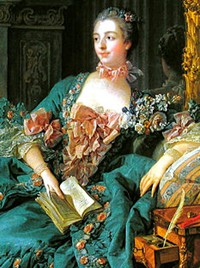Rococo and Neoclassical Portraits
18th-Century Portraiture by Artists of the
Rococo and Neoclassicist Schools.
MAIN A-Z INDEX - A-Z of PAINTING
|
Rococo and Neoclassical Portraits |
|
|
Rococo & Neoclassical Portraits (c.1760-1850)If the seventeenth century had been an age of warfare and religious confrontation, the eighteenth century was a calmer Age of Reason and Enlightenment. This was reflected in two differing styles of painting: the first was Rococo - a light-hearted, whimsical style of decorative art supported by Louis XV and Madame de Pompadour, and exemplified by Jean-Antoine Watteau, Jean-Honore Fragonard, Francois Boucher and Giambattista Tiepolo; later, a second style emerged known as Neoclassical painting. Most influential in architecture, the more serious, heroic style of Neoclassical art was, like Rococo, centered on France though it soon spread across the world. These two 18th century schools of painting gave rise to two differing styles of portrait art. |
 Portrait of Madame de Pompadour (1756) Alte Pinakothek, Munich. By Francois Boucher the greatest Rococo portraitist in France. |
|
WORLD'S TOP PORTRAITURE |
Rococo Rococo-style portraitists stressed graceful elegance in their subjects, rather than the grandness highlighted during the Baroque period. Examples include: the painting of Tsar Peter the Great by Jean-Marc Nattier, or in the self portrait by Nicolas de Largilliere. Perhaps because it originated as an interior decorative style, Rococo also paid great attention to the texture and details of dress, as well as the financial status of its sitters. In France, this was exemplified by the Rococo artists Francois Boucher and Hyacinthe Rigaud, as well as by the two dozen pictures of Marie-Antoinette painted by the female portraitist Marie-Louise Elizabeth Vigee Le Brun. In England, notable Rococo portrait artists included Sir Joshua Reynolds and Thomas Gainsborough., as well as the Scottish master Allan Ramsay, official portraitist to King George III. Reynolds was a staunch admirer of the female Swiss portraitist Angelica Kauffmann (1741-1807). See also works by the female French portrait artist Elisabeth Vigee-Lebrun (1755-1842). Other notable examples of Rococo portraiture included: Goethe in the Campagna (1787) by the German artist Johann Heinrich Wilhelm Tisschbein, and Mozart at the Pianoforte (1789) by the Austrian painter Joseph Lange. See also: Rococo Artists. |
|
BEST PORTRAITS |
Neoclassicism By comparison, the more academic Neoclassical style of portraiture displayed more gravitas and a keener sense of history. One of the early pioneers of neoclassicist portraiture was the 'German Raphael' Mengs (1728-79). Other Old Masters of this school included: Jacques-Louis David (The Death of Marat, 1793, and Napoleon Crossing the Alps, 1801); and Jean Auguste Dominique Ingres (Portrait of Napoleon on the Imperial Throne, 1806, and the Grand Odalisque, 1814). Ingres also borrowed from Rococo - witness his attention to the luscious drapes in his Grand Odalisque (1814), and the costume in his Portrait of Baroness Betty de Rothschild (1848). The Neoclassicism of Spanish artist Francisco de Goya was different. Instead of drawing on allegorical or historical narrative, Goya used drama and realism to create an impact. Examples of his classical portraits include: Wellington (1816). See also: Neoclassical Artists. In America, two famous painters who specialized in figure painting and portraits were the Realist John Singleton Copley (1738-1815) - the most distinguished of the Boston and New England portraitists, known for works like Mr and Mrs Ralph Izard (Alice Delancey) (1775) - and Gilbert Stuart (1755-1828), a virtuoso painter in the 'grand manner', known for his portraits of the first five US presidents, including: George Washington (1796). |
|
• For more about the different types
of painting (portraits, landscapes, still-lifes etc) see: Painting
Genres. ENCYCLOPEDIA OF ART |